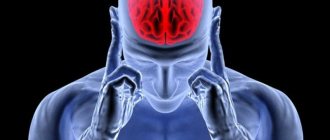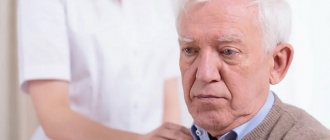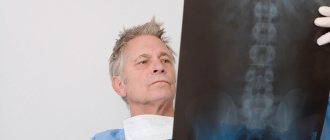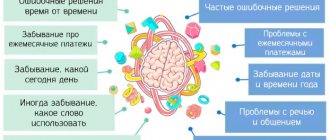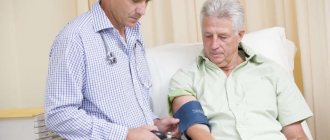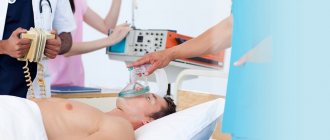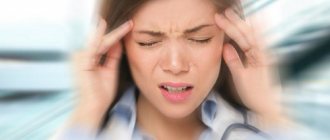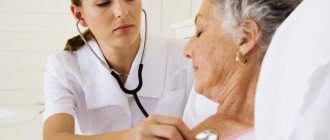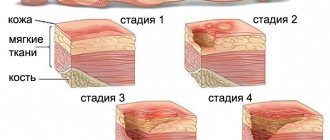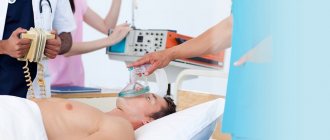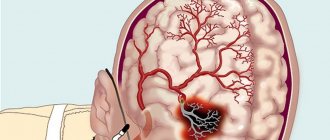From this article you will learn:
- What are the causes of ischemic stroke in older people?
- What are the types of ischemic stroke in older people?
- What are the symptoms of ischemic stroke in older people?
- What are the consequences of ischemic stroke in older people?
- How to treat elderly people with ischemic stroke for elderly people
In older people, the elasticity of blood vessels noticeably decreases, atherosclerotic plaques and blood clots begin to appear, and persistent spasms occur. All this impedes blood flow, causing blockage of blood vessels and provoking the development of a stroke. The disease is manifested by deviations in usual actions: the arm and leg on one side of the body weaken, the symmetry of the face, facial expressions, speech, vision, and coordination of movements are disrupted. A person cannot smile, pronounce words clearly, raise his hands; changes and even loss of consciousness are possible. Everyone needs to know these signs of illness. We will talk about what else is accompanied by ischemic stroke in older people in our article.
Causes of ischemic stroke in older people
The main blood vessels that provide blood flow to brain cells (carotid, vertebral arteries) are called cerebral. If their patency is impaired, a cerebral infarction (ischemic stroke) develops. The cause may be a detachment of a blood clot, an increase in atherosclerotic plaque, or persistent vasospasm. When a blockage occurs, brain cells no longer receive enough oxygen and nutrients, causing irreversible tissue changes in that area.
The frequent manifestation of ischemic stroke in older people is associated with age-related organic changes in the walls of blood vessels, their compaction, and the deposition of cholesterol on them. Regular circulatory disorders in the body associated with other diseases and pathologies also have an effect:
- atherosclerosis of coronary vessels, peripheral arteries;
- obesity;
- hypertension and secondary hypertension;
- hereditary predisposition;
- metabolic syndrome;
- diabetes;
- lipid metabolism disorder (dyslipidemia);
- nicotine addiction;
- chronic alcoholism.
Disorders of cerebral hemodynamics can be provoked by a sedentary lifestyle, consumption of large amounts of fatty meat products and sweets, and frequent stressful situations.
We recommend
“Stroke in an old person: causes and consequences” More details
With age, the risk of ischemic stroke in older people increases; after 55 years, it is more common than hemorrhagic. Rupture of cerebral vessels and hemorrhage occur mainly in persons suffering from prolonged arterial hypertension, atherosclerotic artery disease, and amyloidosis. Uncontrolled use of drugs that prevent blood clotting can also cause hemorrhagic stroke.
Among the potential victims of vascular pathology of the brain, most of them are those who suffer from diabetes. This connection has its own explanations. :
- angiopathy (changes in the thickness of the walls of blood vessels) develops against the background of increased glucose levels in the blood;
- due to constant efforts aimed at removing glucose and fluid from the body, dehydration occurs and the blood thickens;
- tissues chronically lack nutrients, because due to a lack of insulin, glucose does not enter the cells;
- Against the background of diabetes, it is difficult for the body to form bypass pathways to restore blood supply to the affected area.
The excessive obesity of many diabetics is associated with a violation of not only carbohydrate but also fat metabolism. Insulin deficiency leads to increased cholesterol levels in the blood, which, in turn, causes the early manifestation of atherosclerosis, which is quite severe.
Hence the prevalence of extensive forms of ischemic cerebral infarction in older people, accompanied by complications and frequent death.
Types of ischemic stroke in older people
Acute ischemic cerebrovascular accident has several stages. Each develops in its own way and has its own characteristics.
1. Acute stroke.
It is considered the initial period of development of ischemic stroke and lasts no more than 21 days. Pathogenetic changes in brain tissue occur especially quickly during the first 6 hours of illness. In 5–7 minutes, a nucleus is formed from damaged cells; after an hour and a half, the penumbra around it increases by 50%, and after 6 hours – by 80%.
If the necessary medical care is provided in the first 6 hours, the ischemic cerebral infarction will pass, leaving almost no serious negative consequences for older people. Since as a result of pathogenetic processes, brain cells begin to die from the first minutes, if treatment does not start on time, apoptosis will spread exponentially. And after 3–5 days, necrosis of the damaged cells will occur.
Intensive therapy during the first 6 hours includes:
- improving blood supply to brain tissue;
- protecting cells from destruction;
- improving viscosity, coagulability and microcirculation of blood in the smallest vessels of the brain;
- prevention of cerebral edema.
In addition to acute, there are other, more complex types of brain disorders.
2. Major stroke.
Large vessels supplying blood to the brain are susceptible to extensive ischemic stroke. A condition in which many small areas of brain tissue or, conversely, a large fragment is affected, is also considered a major stroke. This is a serious disease with obvious symptoms of brain damage in older people:
- depression of consciousness;
- cerebral edema;
- hemiparesis or hemiplegia on the opposite side of the lesion;
- paresis of gaze towards paralyzed limbs;
- disorder of consciousness;
- autonomic disorders;
- trophic disorders.
The manifestation of certain symptoms is affected by the location of the damaged hemisphere - on the right or on the left. A common sign of ischemic stroke in older people is deep fainting, during which you should carefully look at the patient’s pupils, shining a light directly into his eyes. If the pupils do not react to light and do not dilate, then perhaps a massive stroke is beginning. An elderly patient can only be saved by urgent hospitalization in the intensive care unit, where he will be connected to a life support system.
3. Lacunar stroke.
The most common type of cerebral vascular pathology is lacunar. But it can only be determined in a hospital, albeit in the very early stages. A lacunar stroke damages the deep layers of brain tissue, resulting in the appearance of cavities (lacunae) with a diameter of 1 to 15 mm. Small lacunae, merging, form larger ones, and blood or plasma and fibrin can already accumulate in them.
The development of lacunar ischemic stroke does not impair vision, speech, consciousness, or other functions of the cerebral cortex, since all pathological processes occur deeper. There are no symptoms of brain stem damage. Such differences distinguish this type of stroke from other types of disease.
Recommended articles on this topic:
- How to prevent stroke using folk and medical remedies
- Brain medications for older people: top 10 best drugs
- Caring for older people after a stroke: features, rules and recommendations
Sudden jumps in blood pressure can trigger the occurrence of lacunar ischemic cerebral infarction in older people. Therefore, at risk are those patients who have the following pathologies:
- hyaline dystrophy AG;
- atherosclerosis;
- infectious inflammation of arterioles;
- diabetes;
- vasculitis.
The consequences of lacunar ischemic stroke in older people are very sad: memory loss, impaired spatial orientation, deep depression, and subsequently dementia.
Symptoms of ischemic stroke in older people
Most often, ischemic cerebral infarction occurs at rest or even during sleep. The process develops gradually, more slowly than with the hemorrhagic form, but it still begins unexpectedly, and the manifestations progress quickly.
Since cell damage occurs in separate areas of the cerebral cortex, symptoms arise in the form of focal disorders.
Clinical manifestations of blockage or spasm of the carotid arteries:
- reduction (paresis) or complete loss (paralysis) of the ability to move limbs on one side of the body;
- pathological muscle tone and reflexes;
- paresis of facial muscles - impaired facial expressions, immobilization of half the face, distortion, inability to smile evenly, raise eyebrows, smoothness of the nasolabial fold, drooping of the corner of the eye, lips;
- loss of sensitivity in the affected limbs;
- blurred vision, flashes of light, visual hallucinations;
- slurred speech;
- inability to act purposefully (apraxia);
- violation of the eye, difficulty determining the distance to objects, their relative position;
- emotional and mental disorders.
Signs of ischemic stroke in older people that cause reasonable concern:
- sudden numbness of the limbs or any other part of the body;
- loss of control over one’s body – it is difficult for an elderly person to understand what is happening to him or where he is;
- speech disorders (incoherent words, the victim does not understand what others are saying to him);
- blurred vision, the image in the eyes is double, the field of view is partially lost;
- a distorted face, the corners of the mouth droop; if you ask the victim to smile, he will not be able to do so;
- paralysis of any limb - it is impossible to raise an arm or leg, or move them;
- when the tongue sticks out of the mouth, it deviates from the middle to the side;
- general cerebral disorders - loss of consciousness, convulsions, nausea, vomiting, headache.
The consequences of the disease, which will subsequently affect a person’s standard of living, ability to work, and do without outside help, depend on the timely start of treatment. In most cases, older people who have suffered a stroke can no longer return to their normal lives; they develop vestibular disorders, paralysis, and speech changes.
Left side stroke
Stroke on the left side of the brain occurs more often than stroke on the right side. According to statistics, it accounts for 57% of all stroke cases. In this case, a stroke on the left side has characteristic features, both in symptoms and in terms of treatment and rehabilitation. The fact is that the left and right hemispheres of the human brain perform different functions. The left hemisphere is responsible for logical thinking and speech, the right hemisphere is responsible for emotions and creativity. The perception of new information mainly occurs in the left hemisphere, and the recognition and analysis of information - in the right. In this case, motor signals go from the left hemisphere of the brain to the muscles of the right side of the body, and signals from the right hemisphere to the muscles of the left side.
Therefore, a stroke on the left side of the brain leads to right-sided paresis or paralysis - loss of mobility and numbness of the right half of the face, right arm, and leg.
Another characteristic feature of a stroke on the left side is the loss of speech functions, including speech perception and the ability to speak. After a stroke of the left hemisphere, a person either loses the ability to speak altogether, or his speech becomes inarticulate, consisting of incoherent sounds or separate nouns (this speech is called “telegraphic style”). On the one hand, this greatly facilitates diagnosis, since with a stroke of the right hemisphere, speech is often not impaired, which makes it more difficult to recognize a stroke.
On the other hand, this significantly complicates the social adaptation of a person who has suffered a stroke on the left side of the brain.
Impaired speech function and the ability to perceive speech makes a person withdrawn, depressed, and insecure.
Another complication after a left-sided stroke is a violation of muscle-joint sensation, which also complicates rehabilitation. As for the psychological state of a person after a stroke on the left side of the brain, uncertainty, lethargy, and passivity are combined, however, with the desire to overcome the disease. It can be said that patients with left-sided stroke are more motivated to recover. The main task of the psychologist is to support this desire, encouraging and inspiring the patient to new and new achievements.
As for restoring motor activity, the methods of rehabilitation after a stroke on the left side of the brain are the same as for a right-sided stroke - kinesiotherapy (intensive motor therapy), massage, reflexology.
Diagnosis of ischemic stroke in the elderly
Data from objective and instrumental research methods and their comprehensive competent assessment will help diagnose ischemic stroke in older people:
- neurological examination;
- Ultrasound examination of the arteries of the head and neck;
- computed and magnetic resonance imaging;
- angiography;
- transcranial Doppler ultrasound;
- electroencephalographic study.
Proper diagnosis will help distinguish ischemic stroke from hemorrhagic stroke. Neuroimaging techniques for studying the disease play an important role here. It is necessary to identify and differentiate between ischemic stroke and other brain diseases, for example, acute hypertensive encephalopathy. It is important to distinguish impaired brain activity due to blockage or spasm of blood vessels from toxic or metabolic types of encephalopathy, from brain tumors, abscesses, encephalitis and other brain lesions of an infectious nature.
Treatment of ischemic cerebral stroke in elderly people
Relatives of an elderly person who has suffered a cerebral infarction must understand that in a hospital setting, doctors will monitor the patient’s condition and will be able to provide him with the necessary therapeutic assistance in a timely manner. Patients in a state of deep coma with impairment of all vital functions will not be taken to a medical institution. Hospitalization will not help those who have repeated cerebrovascular accidents complicated by dementia and other mental disorders, as well as patients with incurable somatic diseases.
We recommend
“Care for bedridden patients after a stroke: how to achieve a quick recovery?”
More details Treatment of ischemic stroke follows certain rules:
- It is necessary to influence the activity of the cardiovascular system - with a pronounced decrease in myocardial contractility, cardiac glycosides are used, antihypertensive drugs, calcium antagonists (Nifedipine), beta blockers (Obzidan) and diuretics (Lasix), respiratory analeptics are administered (“Cordiamin”, “Sulphocamphocaine”).
- Correction of homeostasis is carried out by introducing electrolyte solutions (5% glucose solution, 0.9% sodium chloride solution, Ringer's solution, 4% sodium bicarbonate solution, polarizing mixture), low molecular weight dextrans (Reopoliglucin up to 400 ml), correction of hypokalemia, hypochloremia .
- To combat cerebral edema, 10 ml of 2.4% Euphyllin, 1 ml of Lasix, and, if necessary, Mannitol and urea are injected intravenously; antihistamines (Diphenhydramine, Pipolfen), novocaine; Hydrocortisone, dexamethasone, prednisolone, glycerin can be used orally.
This is how vegetative disorders are eliminated:
- at high temperatures, “lytic” mixtures are prescribed, including diphenhydramine, novocaine, analgin;
- neurovegetative blockade is carried out using droperidol, diphenhydramine, aminazine;
- It is advisable to rub the patient’s body with alcohol until red, which increases heat transfer;
- To reduce the temperature of large vessels, local cooling of the carotid arteries, axillary and groin areas is carried out, and wrapping with damp sheets is carried out.
In case of hemorrhagic stroke, blood clotting is increased and the permeability of the vascular wall is reduced using calcium preparations (10 ml of a 10% solution of calcium chloride intravenously or calcium gluconate intramuscularly), “Vikasol” (2 ml of 1%), 5–10 ml of a 3% solution of ascorbic acid, gelatin 10% – 20–50 ml intravenously, rutin, rutamin, e-aminocaproic acid (5% – up to 100 ml), “Ditsinon” (2 ml–250 mg) intravenously or intramuscularly; surgical treatment is possible - puncture stereotactic removal of the lateral hematoma after CT, various methods of surgical treatment of cerebral aneurysms.
Note that in case of ischemic stroke the following is done:
- increase blood flow to the brain by dilating regional cerebral vessels and reducing vasospasm, improving collateral circulation, using vasodilators (10 ml of 2.4% Eufillin solution intravenously), nicotinic acid (1% solution 1-2 ml intravenously), Stugeron ", "Trental" and others;
- improve venous outflow by administering cocarboxylase (50 mg) and Dietifen (10 mg);
- normalize blood coagulation and rheological properties with the help of heparin (5000–10000 units intravenously or intramuscularly for 3 days), “Phenilin” and other indirect anticoagulants (up to 2–3 months), acetylsalicylic acid, “Complamin”, “Prodectin”, "Trental" and others.
Increasing the resistance of brain tissue to low oxygen levels and improving brain metabolism is carried out through the use of tissue metabolism inhibitors (neuroleptics, regional hypothermia) ATP, vitamins and amino acids (cocarboxylase, glutamic acid, glycine, B vitamins, vitamin E), nootropics (Aminalon ", "Piracetam"), "Cerebrolysin", "Actovegin", hyperbaric oxygenation.
An elderly patient with ischemic stroke should be under constant monitoring, so it is necessary:
- every 1–2 hours, monitor indicators of circulatory restoration, check how the patient is breathing, taking into account the nature and frequency of respiratory movements;
- monitor the condition and appearance of the skin and determine the water balance daily;
- it is very important to adhere to bed rest with all the necessary procedures for caring for a bedridden patient;
- a sedentary state can provoke the appearance of pneumonia, constipation, urosepsis, thromboembolic complications, so special attention should be paid to the prevention of such conditions;
- prevent the development of contractures;
- establish a way of communicating with an elderly patient if speech disorders, tongue-tiedness appear, and perform speech therapy exercises;
- if swallowing is impaired, provide parenteral feeding and tube feeding;
- if there is a high temperature, care for the elderly patient as in the second period of fever.
Ischemic stroke
Stroke can be ischemic or hemorrhagic. Ischemic stroke occurs on average five to six times more often than hemorrhagic stroke
- Etiopathogenesis of ischemic stroke
Most often, two types of ischemic stroke are observed: thrombotic, caused by primary thrombotic occlusion of cerebral vessels, and embolic, caused by embolism from a distant source. Primary thrombotic occlusion usually develops in a vessel whose lumen is narrowed as a result of atherosclerosis, for example in the carotid or basilar artery. The most common source of embolism is the heart. Cardiogenic embolism can occur with atrial fibrillation or myocardial infarction (due to mural thrombus formation), with prosthetic valves, infective endocarditis, and atrial myxoma. Less commonly, the source of emboli is ulcerated atherosclerotic plaques in the aortic arch and the mouth of the great vessels. Atherosclerosis of the carotid artery can be the cause of its primary thrombotic occlusion, but more often it is the source of embolism of the intracranial arteries. Rare causes of ischemic stroke include cerebral vein thrombosis, erythrocytosis, meningovascular syphilis, arteritis due to tuberculosis and collagenosis, dissecting aortic aneurysm.
- Classification of ischemic stroke
Strokes are classified according to their suspected pathophysiological mechanisms. First of all, clinical manifestations and their dynamics are assessed. Depending on how long the neurological defect persists, transient cerebral ischemia (PIM), also called transient ischemic attack (TIA) with complete recovery within 24 hours, minor stroke (full recovery time is more than 24 hours, but less than one week) are distinguished. ) and completed stroke (the defect persists for more than one week). Neurological disorders during embolism usually develop suddenly and immediately reach maximum severity; Stroke may be preceded by attacks of transient cerebral ischemia, but they are observed much less frequently than in the case of primary thrombotic occlusion. In thrombotic strokes, neurological symptoms usually increase gradually or stepwise in a series of acute episodes over several hours or days (progressive stroke). In the future, the diagnosis is based on the definition of:
- localization of the lesion;
- the nature of the vascular pathological process;
- information about preserved pathways of collateral blood flow in the ischemic zone.
If an accurate diagnosis can be called an inevitable factor in adequate therapy, then a necessary condition for the correctness of the latter is the study of the clinical picture of the disease, that is, the neurological condition of the patient directly at his bedside.
Thus, the diagnosis of a stroke symptom complex is based on the dynamics of the clinical picture and a characteristic set of subjective and objective symptoms.
- Ischemic Stroke Clinic
Strokes in 80% of cases are observed in the middle cerebral artery system, and in 20% in other cerebral vessels.
Ischemia in the middle cerebral artery basin. Available clinical experience shows that before the development of cerebral infarction, vessel narrowing is usually “prevented” by TIA in the middle cerebral artery basin. Their symptoms are similar to those of TIA, associated with deterioration of hemodynamics as a result of severe stenosis of the internal carotid artery, however, in contrast to the latter, the trunk of the middle cerebral artery and its branches are usually blocked by an embolus.
| In our country, as in other civilized countries of the world, stroke is the third leading cause of increased mortality after cardiovascular diseases and cancer. Stroke is a pathology that affects the working population, leading to prolonged hospitalization, persistent disability of patients, deterioration in the quality of life of their families and significant economic costs for the state. |
A few days before a stroke, the patient experiences headaches, weakness, blurred vision, dizziness, and transient numbness in the arm and leg. The phenomena increase, and one day in the morning the arm and leg stop working. The patient may not lose consciousness, but notices “fog” in the head. Or there may be a sudden, “stroke-like” development, which in the acute period is practically no different from a hemorrhagic stroke. With the development of right-sided hemiplegia, speech disorder in the form of more or less pronounced aphasia can be persistent. With lesions of the parietal cortex and internal capsule of the brain, the patient develops anosognosia, metemorphopsia, autoagnosia with delusional constructs. The patient has a body schema disorder with distorted perception at the border of the lost visual field, but he does not understand his condition.
Cases of the disease in which there is an extensive focus of softening as a result of switching off both the subcortical and cortical branches of the middle cerebral artery are very severe. Often such patients do not get out of bed, especially if they develop early flexion contracture in the paralyzed leg, which is poorly amenable to treatment. In relatively mild cases, after 1-2 months, movements in the limbs begin to recover, but recovery in the leg is better than in the arm.
With frequent occlusion of individual branches of the middle cerebral artery, incomplete syndromes arise: motor aphasia with contralateral paresis of the arm and facial muscles of the lower half of the face with occlusion of the upper branches, sensory aphasia with occlusion of the lower branches, and others. Mono- and hemiplegia leave an indelible mark on the patient’s motor skills; sometimes a hemiplegic gait (usually in the form of the famous Wernicke-Mann pose with a bent arm and straightened leg) can remain for life. In the paralyzed limb, vasomotor-trophic disorders are noted: coldness, cyanosis, swelling, arthropathy with severe pain in the joints, which leads to their sparing and thereby contributes to the development of contractures and atrophies. This is why restorative measures during the rehabilitation period are so important.
Ischemia in the anterior cerebral artery basin. With the same general symptoms, the peculiarity of the clinical picture is the predominant lesion of the leg in hemiparesis, sometimes in the form of hemiplegia. With a left-sided focus, transient motor aphasia is observed. Mental disorders characteristic of damage to the frontal lobes often appear.
Ischemia in the basin of the posterior cerebral artery. The picture is very diverse depending on the location of the occlusion. Thus, when the entire channel is blocked, there may be hemiparesis, hemianesthesia or hemihyperesthesia, hemiataxia, hemianopsia, and with left-sided localization also sensory aphasia. When only the cortical branch is blocked, hemianopsia is observed, while the lower thalamic branch is blocked - choreoathetosis and painful hyperpathies. The latter are treated with powerful neuroleptics (aminazine).
Ischemia in the basin of the basilar and vertebral arteries. The clinical picture is very diverse: from tetraplegia with bilateral horizontal gaze paresis with thrombotic occlusion of the basilar artery trunk; nystagmus, dizziness, nausea, dysphagia with stenosis of the intracranial vertebral artery - to headaches, dizziness and noise with the common vertebrobasilar insufficiency against the background of cervical osteochondrosis.
Ischemia in the carotid artery basin. Occlusion of the carotid artery (stenosis, thrombosis, embolism) is often asymptomatic, but in the case of neurological disorders they are associated mainly with insufficient blood supply in the middle cerebral and sometimes anterior and posterior cerebral arteries. Usually there is a so-called “flickering” of symptoms. Developing hemiparesis, or even complete hemiplegia with aphasia and the alternating blindness combined with them disappear after a few minutes or hours. This is due to the restoration of blood flow through the circle of Willis, through anastomoses with the external carotid artery. Increased pulsation in the facial arteries and low pressure in the retinal arteries usually indicate stenosis or occlusion of the internal carotid artery on the same side. A thrombus in a great vessel in the neck can be palpated, verified angiographically, and promptly removed by a surgeon.
Lacunar infarction. Develops as a result of occlusion of small penetrating arteries by atherosclerotic plaque or lipohyalinosis, which is more common in arterial hypertension and diabetes mellitus; however, their embolism is also possible. They are mostly asymptomatic; scant single symptoms (dysarthria, clumsiness of the hand, gaze paresis or ataxic hemiparesis) occur against the background of a normal EEG (the diameter of the lesion does not exceed 1 cm).
Transient cerebrovascular accidents. These disorders most often occur in the form of TIA, when the focal deficiency regresses within a day. The specific symptoms of these attacks make it possible to judge the involvement of a particular artery and the localization of the lesion, which is of no small importance for determining treatment tactics. The latter is most often planned taking into account not only and not so much the location as the nature of the lesion. For example, a single attack of speech disorder and hand weakness, relieved after 12 hours, most likely indicates an embolism, and you need to look for the source. Short-term (up to 15 minutes) and frequent (5-10 times a day) single attacks indicate transient disorders of cerebral circulation, local occlusion against the background of atherosclerosis with insufficient development of the collateral system.
Thus, it becomes clear that in case of transient disorders with transient ischemic attacks, the following are especially important:
- insufficiency of collateral blood flow to the ischemic zone;
- state of blood coagulation and anticoagulation systems;
- level of blood pressure, serum cholesterol, the presence of impaired tolerance to carbohydrates, as risk factors for the development of atherosclerotic process (thrombosis, ulceration, embolism, stenosis), leading to vascular occlusion in the brain.
- Diagnosis of ischemic stroke
Despite the fact that a diagnosis can be made based on anamnesis, neurological examination and laboratory data, the following methods are important both in diagnosis and in differential diagnosis and prediction of outcome:
- computed tomography, which allows you to distinguish a heart attack from a hemorrhage, that is, to clarify the nature of the stroke (hemorrhagic or ischemic);
- magnetic resonance angiography, which is not very suitable for emergency situations, but is safe due to its non-invasiveness;
- Dopplerography, especially transcranial, which allows you to assess the state of cerebral blood flow;
- cerebral angiography, which is indispensable if surgery is planned;
- EEG, which identifies areas of cortical and subcortical damage;
- scintigraphy and positron emission tomography, which allow assessing cerebral metabolism and are important in the stage of transient cerebrovascular accidents and at the very beginning of a stroke.
Currently, the improvement of clinical diagnostics and neuroradiological research methods makes it possible to clarify the nature and localization of strokes, as well as to study the accompanying vascular lesions with high frequency and accuracy, which makes treatment more targeted, possible and mandatory.
- Treatment of ischemic stroke
Treatment for ischemic stroke mainly has three goals:
- stroke prevention by reducing risk factors;
- preventing a first or recurrent stroke by removing the underlying lesion - for example, performing a carotid endarterectomy;
- prevention of secondary brain damage by maintaining adequate perfusion in the marginal areas of ischemic zones and reducing edema.
Modern pathogenetic ideas. The development of acute cerebral ischemia triggers pathobiochemical cascade reactions, the outcome of which is the formation of a heart attack.
Analysis of the “ischemic cascade” indicates two possible directions for the treatment of ischemic stroke: the first is improving the perfusion of brain tissue, and the second is neuroprotective or cytoprotective therapy. Early and comprehensive intervention is most promising. The effectiveness of treatment measures depends on the timeliness of their initiation and on the continuity of therapy in all periods of the disease.
System of step-by-step provision of medical care. In Russia, the following system of providing medical care to patients with cerebral stroke has been developed and is functioning: 1. Pre-hospital stage (specialized neurological and linear ambulance teams); 2. Intensive care stage (neurointensive care units, intensive care units, neurosurgical departments); 3. Stage of rehabilitation treatment (neurological departments, rehabilitation departments, centers); 4. Dispensary stage (district neurologist, therapist).
The continuity of treatment measures is determined by the general tactics of patient management and is associated with the solution of treatment and organizational problems. Along with differentiated therapy for strokes, basic therapy aimed at maintaining the vital functions of the body plays an important role. The more severe the stroke, the more necessary, multifaceted and complex basic therapy becomes, which is carried out individually, under the control of laboratory parameters, functions of all organs and systems (see abbreviated diagram of the Department of Neurology and Neurosurgery of the Russian State Medical University, 1997).
Basic therapy. Basic therapy primarily involves proper patient care. For several days the patient should be in a horizontal position with his legs elevated. From the very beginning, it is necessary to prevent hypostatic pneumonia, purulent corneal ulcers, bedsores, and early contractures. After the end of the stroke, within 24-48 hours it is necessary to begin passive movements in the joints, turn the patient in bed, and clear his airways. For persistent vomiting, a nasogastric tube is inserted; for dysphagia, parenteral nutrition is indicated. Control the function of the excretory organs.
| Treatment of strokes involves the combined use of many medicinal, non-medicinal, and surgical agents, prescribed strictly according to indications and under laboratory control, with the participation of cardiologists and, if necessary, resuscitators and neurosurgeons |
Blood pressure control is carried out in order to establish systolic pressure at a level of 10 mm above the “working” numbers, diastolic pressure - no higher than 120 mm Hg. Art. Treatment of concomitant heart pathology is necessary: antiarrhythmic drugs according to indications, anti-infective drugs for septic endocarditis, etc.
Regulation of water-salt metabolism is carried out by infusion therapy under the control of pH measurements, osmolarity of urine and blood, electrolytes and biochemical blood tests.
In the fight against cerebral edema and in order to prevent increased intracranial pressure, dexazone (8 + 4 + 4 + 4 mg IV) is preferable - in the absence of severe forms of diabetes mellitus, internal bleeding, malignant arterial hypertension - or osmotic diuretics (2 times a day reogluman, mannitol 15% - 200 ml IV drip, after 10-15 minutes Lasix 20 mg IV).
Cardiologists and resuscitators should participate in basic therapy.
Anticoagulants. They are prescribed only if it is possible to control blood clotting and in the absence of hemorrhagic diathesis, exacerbation of peptic ulcer disease, severe kidney and liver diseases.
Heparin is administered at a dose of 5,000-10,000 units every 4 hours intravenously, or 1,000 units/hour by drip. The dose is adjusted so that the clotting time or active thromboplastin time is doubled. Coagulation rates are determined daily. In case of heparin overdose, determined laboratory or clinically (petechiae, microhematuria), protamine is administered (5 ml of 1% protamine solution in 20 ml of saline solution). It can be administered, according to the manufacturer's instructions, four hours after the administration of heparin.
After 1-2 days, with the abolition of heparin, they switch to indirect anticoagulants: phenylin, syncumar, warfarin, dicoumarin. Daily monitoring of prothrombin time is necessary. These drugs are prescribed for 3-4 weeks. The effect of indirect anticoagulants is eliminated in urgent cases with plasma (20 ml/kg) or intravenous administration of 50 mg of vitamin K. After the patient is discharged, the prothrombin time can be determined 1-2 times a month.
Antiplatelet agents. The use of antiplatelet agents is due to the fact that platelet aggregation triggers the blood clotting process. They are prescribed from the 3-5th day of a stroke and can be used for years and even for life in courses or permanently. The greatest clinical, although contradictory, experience has been accumulated with aspirin, dipyridanol and ticlid. Aspirin, which selectively suppresses the synthesis of thromboxane A-2, is prescribed mainly at a dose of 1 mg/kg, although there are studies confirming the effectiveness of 30 mg per day, and vice versa, there are studies that indicate the effectiveness of a dose of 325 mg per day. Tiklid is prescribed 250 mg 2 times a day. It is necessary to monitor the condition of the gastrointestinal tract with possible prevention and treatment with antacids, mineral water, herbal medicine, and control of peripheral blood.
Treatment of ischemic stroke in the acute period | ||||||
| * bleeding time * blood clotting * prothrombin * antithrombin * fibrinogen * blood viscosity | 0 | 3 hours | 3-5 days | 7-10 days | 21 day | |
| rtPA!: 0.9 mg/kg i.v., i.v. | End of the acute period | |||||
| Plasma: Day I - 100-150 ml x 1 r.; IV day - x1 rub. | ||||||
| Heparin therapy: 10-15 thousand units/day. through a perfusor or 2.5 thousand units subcutaneously in the abdomen x 4 times. Reduce the dose of heparin by 5 thousand units. Indirect anticoagulants: | phenyline 0.03 g x 2-3 r. or syncumar 8-16 mg/s | |||||
| Hemodilution: rheopolyglucin, rheomacrodex (taking into account systemic hemodynamics, reduce Ht to 30-35%) | ||||||
| Individual antiplatelet therapy (possibly a combination of two drugs) | ||||||
| Trental: 5-10 ml x 2 r. IV jet or x 2 r. IV drip | 0.15-0.2 g x 3 r. per os continue for 2-3 months. + additional REG control | |||||
| Beta blockers: obzidan (anaprilin) 10-20 mg x 4 r. per os | continue for 2-3 months. | |||||
| Calcium antagonists: nimotop 60 mg x 3-4 r. per os | ! 30 mg x 3-4 r. 1.5-2 months | |||||
| Eufillin: 2.4% -7 ml x 2 r. IV drip | x 1 rub. IV drip | |||||
| Stugeron (cinnarizine): 25 mg x 3 r. per os | Continue for 1.5-2 months. | |||||
| Cavinton: 20 mg per 500 ml. physical solution intravenously drip | 10 mg per 500 ml saline. IV drip solution 15 days | 5-10 mg x 3 r. per os for 2-3 months. | ||||
| Tiklid: 250 mg - 1-2 times, long-term + control of peripheral blood | ||||||
| Contrical, gordox i.v. | Aspirin: 1.0 mg/kg per day, long-term | |||||
| Dicinone: 250 mg x 4 r. per day i.v. or x 2-4 times i.m. | If necessary, 250 mg 3 times. continue for 1.5-2 months | |||||
| Neuroprotective therapy: | ||||||
| EEG | Glycine: 1 g x 1-2 r. sublingually | 0.1-0.2 g x 3 r. sublinvally for 1.5-2 months. | ||||
| Control | Nootropil: 12 g/day intravenously for up to 15 days | 5 ml/day. IM for 5 days | 2.4 g x 2 r. per os in table. or in syrup during 2-3 months | |||
| Cerobrezin: 10-20 mg/day IV drip | 5 ml/day. IM for 5 days | 2 days break 3-4 courses | ||||
Individual antiplatelet therapy involves the prescription of vascular drugs with antiplatelet activity: trental, beta blockers, calcium antagonists, stugeron, cavinton, aminophylline. Hordox and Contrical can be administered intravenously in the acute period (see diagram).
Even with the initial manifestations of insufficiency of blood supply to the brain (IBC), it is recommended to prescribe antiplatelet agents containing nicotinic acid (enduracin), polyunsaturated fatty acids (eikonol) or iodine (Splat, spirulina, sea kale).
Vasodilators. Amyl nitrite, papaverine, isoxsuprine can increase cerebral blood flow, but they are not very effective. In addition, vasodilation can lead to a decrease in blood supply specifically in the ischemic zone (“steal”).
Neuroprotective therapy. Neuro- or cytoprotective therapy is necessary to influence the main links of the “ischemic cascade”. From the very first day, Cerebrolysin (10-20 ml), nootropil (12 g per day), glycine (1-2 g sublingually), Semax (6-9 mg intranasally) can be prescribed intravenously. Aplegin 5 ml per day intravenously is effective. After 10-15 days, you can switch from parenteral to oral administration of drugs.
Other means. In recent years, there has been renewed interest in thrombolytics - streptokinase, urokinase and, especially, altepase and nasaruplase, synthesized by genetic engineering methods and having a selective effect on thrombus. However, the results of their studies, as well as those of naloxone (an antagonist of narcotic analgesics), barbiturates, and glutamate receptor blockers, are ambiguous. These drugs do not yet have clinical significance.
Rehabilitation activities. In the recovery phase, when the patient’s condition improves, speech therapy, massage, physiotherapy, reflexology, and therapeutic exercises are important.
Surgery. It is possible only with strict consideration of indications and contraindications and in specialized hospitals and centers. The most common operation is carotid endarterectomy (CE), which is performed for arterial stenosis of more than 70%, as well as for less severe stenosis if there is ulceration of the plaque. The operation can be performed both for prophylactic purposes and urgently during a stroke. Analysis of the literature showed that CE is most often performed in patients who have suffered a TIA or minor stroke as a result of atherosclerotic stenosis of the internal carotid artery.
Surgeries are less often performed for lesions of the extracranial vertebral arteries, subclavian “steal” syndrome, lesions of the aortic arch, cerebellar infarction with compression of the brain stem (decompression of the posterior cranial fossa).
Literature
1. Barkhatov D. Yu., Dzhibladze D. N., Nikitin Yu. M. Functional transcranial Dopplerography in atherosclerotic lesions of the carotid arteries // Journal of Neurology and Psychiatry named after. Korsakova, 1994, 94, 2: 12-16. 2. Vereshchagin N.V., Dzhibladze D.N., Gulevskaya T.S. et al. Carotid endarterectomy in the prevention of ischemic stroke in patients with atherosclerotic stenosis of the carotid arteries // Journal of Neurology and Psychiatry named after. Korsakova, 1994, 94, 2: 103-108. 3. Gusev E. I., Skvortsova V. I., Chekneva N. S. et al. Treatment of acute cerebral stroke (diagnostic and therapeutic algorithms). Educational and methodological literature. M., 1997. 4. Neurology. Ed. M. Samuels. M., 1997. 5. Kistler J.F., Ropper A.H., Martin J.B. Vascular diseases of the brain. Internal Medicine 10: 44-107. 6. Barnett HJM Aspirin in stroke prevention. Stroke 21 (Suppl IV): IV-40, 1990. 7. The Dutch TIA Trial Study Group. A comparison of two doses of aspirin in patients after a transient ischemic attack or minor ischemic stroke // N. Engl. J. Med., 1991. 325: 1261 8. Hass WK et al Control trial of aspirin for the prevention of stroke in high-risk patients // N. Engl. J Med 1989 321:501 9. Petty GW et al. Complications of long-term anticoagulations // Ann. Neurol. 1988. 23: 570 10. Swedish Cooperative Study. High dosage acetylsalicylic acid after cerebral infarction. Stroke 1987.18: 325
Memo on providing first aid to the elderly for ischemic stroke
At the first manifestation of symptoms of an ischemic stroke, it is necessary to call a team of doctors to provide emergency medical care. The effectiveness of further treatment directly depends on the timeliness of these actions. While the ambulance is traveling, you should prepare the elderly patient and take certain actions:
- The victim should be laid so that the shoulders and head are located above the body, this will help reduce blood pressure on the vessels of the brain. You cannot move or shift an elderly person - this can only make him worse.
- You should not give the patient anything to eat or drink while waiting for doctors because of the likelihood that the usual swallowing function will be disrupted; the person will choke or choke.
- It is strictly forbidden to give any medications before the ambulance arrives; you may not alleviate, but, on the contrary, aggravate the condition of an elderly relative.
- The oral cavity must be cleared of any secretions and objects (saliva, blood, mucus, food).
- Provide all conditions for free breathing: increase access to fresh air, remove tight clothing.
- If a person has lost consciousness but is breathing on his own, he must be turned on his side, his head resting on his arm and slightly tilted forward, and his leg bent at the knee so that it does not allow him to accidentally roll over.
- If there is no breathing, the elderly person is placed on his back and given artificial ventilation. If there is no pulse, cardiac massage is added to this procedure. For every two breaths there should be 30 heartbeats (2/30). These measures should be carried out only if you have the necessary skills and abilities until the victim begins to breathe on his own or until the ambulance arrives.
The development of ischemic stroke in older people occurs very quickly, which is why it is so important to provide qualified medical care literally in the first minutes and hours of the disease. Treatment must necessarily take place in the intensive care unit, where all efforts will be devoted to carrying out the necessary medical procedures. The faster this happens, the more favorable the prognosis and outcome of the disease. The optimal time for first aid and treatment is 2–4 hours from the onset of an attack. If you manage to carry out the necessary therapy in this short period of time, you may be able to avoid many complications.
Consequences of ischemic stroke in older people
A disease associated with brain damage necessarily affects the condition of older people. It’s good that the patient survived at all. But his future fate may develop differently. Ischemic stroke left some disabled for life, others were luckier: there were minor changes in the body that did not reduce the quality of life. You can adapt to them or try to recover.
We recommend
“Recovery of elderly people after a stroke: tips and practical recommendations” Read more
Possible consequences of ischemic stroke in elderly people:
- Impaired swallowing function - the patient cannot easily swallow either liquid or solid food, he chokes, this can lead to aspiration pneumonia, and then to death.
- Mental disorders - often those who have suffered an ischemic stroke develop deep depression. Even small changes in the quality of life cause a serious blow to the psyche. Especially if an elderly person has partially lost some everyday skills and needs outside help to do what was previously done without much difficulty. The fear of remaining disabled and becoming a burden for loved ones becomes the cause of a depressed state. A person’s mood changes for no reason, he cannot compose himself, he is timid, and sometimes aggressive.
- Impaired motor function in older people – arms and legs may not immediately regain their former strength and dexterity. Weakness and uncertainty in the legs when walking will force you to pick up a cane; unruly hands will not allow you to perform usual actions - dressing yourself, holding a spoon, etc.
- Loss of sensation in the limbs and face . If muscle strength in the arms and legs is restored quite quickly after an ischemic stroke, then sensitivity does not return to normal for a long time. This is due to the different structure of the nerve fibers (through which impulses travel) responsible for movement and sensitivity.
- Speech impairment may not remain in all older people who have had an ischemic stroke. This complication makes it difficult to communicate with family; a person cannot express his desires or tell his family anything, sometimes uttering a set of incoherent sounds. With right-sided brain damage as a result of ischemic stroke, such complications rarely occur.
- Impaired coordination in space - an elderly person cannot walk confidently, he staggers without assistance, becomes dizzy, and falls during sudden movements and turns.
- Epilepsy – up to 10% of older people after an ischemic stroke are susceptible to unexpected seizures of epilepsy.
- Dysfunction of the pelvic organs - the mechanisms of bowel and bladder emptying are disrupted; after an ischemic stroke, an elderly person cannot always independently control these processes. That is why understanding and careful care from relatives or a caregiver is so important.
- The consequences can manifest themselves in the form of cognitive impairment - memory lapses occur, older people forget familiar things: the names of relatives, telephone numbers, home address, even their name. Their behavior is sometimes no different from the reaction of a small child; patients inadequately assess the current situation and confuse the time and place in which they are located.
We recommend
“Rehabilitation of the elderly: get a taste for life again” More details It is possible
to change the patient’s condition or influence the consequences of an ischemic stroke of the brain, to restore the impaired functions and capabilities of an elderly person only in the first year after the incident. Long-term rehabilitation over several years is not effective and simply does not make sense.
What is ischemia?
Ischemic stroke refers to a number of diseases that are characterized by circulatory disorders in the brain. The pathology is expressed by minor symptoms, which may disappear within a day. But it can also lead to death. The disease may be on the left or right side
. Depending on this, motor activity decreases in the half of the body where the paralysis is localized. For example, with a left-sided disorder, the left hemisphere is affected, with a right-sided disorder, the right hemisphere is affected.
Types of disease
According to the rate of increase in symptoms, the disease is classified as follows:
Advertising:
- The transient type goes away after a day.
- The small species is characterized by attacks for 2-22 days.
- Progressive appearance. Symptoms increase over several hours. The duration varies.
- Total view. In this case, a heart attack is noted.
Severity:
- Mild degree
. Symptoms are minor. Recovery is fast. - Average degree
. The signs are palpable, the symptoms are focal. - Severe degree
. Consciousness is depressed, symptoms are extensive. Long-term therapy is required.
Varieties for reasons:
Advertising:
- The atherothrombic
type occurs against the background of atherosclerosis in the central artery, when a blood clot breaks off and the vessels become clogged. - The cardiac embolic
appearance appears due to embolism of the lumens of blood vessels. Etiology – diseases of the heart and blood vessels. - The hemodynamic
form develops due to diseases of the circulatory system. In this case, hemodynamics are disrupted. - The lacunar
type manifests itself in diabetes mellitus and hypertension. - The rheological
appearance occurs with vascular pathologies.
Reasons for the development of pathology
Ischemic stroke (IS) develops due to blockage or rupture of blood vessels. This is caused by pathologies such as atherosclerosis, diabetes mellitus, and hypertension. When blockage occurs, oxygen starvation occurs. Impaired blood circulation leads to irreversible processes and death of neurons.
Dizziness with cervical osteochondrosis is a fairly common phenomenon that causes a lot of inconvenience to the sick person. This occurs due to compression of the vertebral artery by the bony processes. Read more in the article: “dizziness with cervical osteochondrosis.”
There are risk factors:
Advertising:
- smoking and drinking alcoholic beverages;
- deterioration of lipid metabolism;
- migraine;
- age-related changes;
- diseases of the endocrine system;
- diabetes;
- osteochondrosis of the cervical spine;
- arrhythmia, hypertension and other heart diseases;
- pacemakers, artificial valves;
- thrombosis and inflammatory processes in the heart;
- vasculitis and connective tissue pathologies;
- hormonal imbalance and high blood viscosity;
- aneurysm and hypovitaminosis;
- intoxication and low blood clotting;
- taking anticoagulants.
Main symptoms and signs
Ischemic stroke of the left side, consequences, how long do they live? And many other issues that are considered important for this disease. It doesn't even matter whether it's the left side or the right. After all, irreversible changes happen too quickly. Therefore, it is extremely necessary to pay attention to symptoms in a timely manner in order to prevent death.
The main symptom is unnatural asymmetry of the face.
- Symptoms of a general cerebral nature
manifest themselves as sudden and severe headaches and dizziness. Nausea and vomiting, cramps. Consciousness is also impaired, and fainting occurs. - Focal signs are characterized
by cuts or paralysis of the limbs and even the entire half of the body. In addition, there is curvature of the facial muscles, impaired perception of all senses - smell, hearing, visual acuity. This can manifest itself on one side or on both sides at the same time. Sensitivity and memory are lost, coordination and speech are impaired. - Vegetative signs
: a feeling of fear, shortness of breath, changes in heart rhythm, redness of the skin or, conversely, paleness. Also trembling in the body, increased sweating, fever, panic, anxiety.
What are the prognosis for ischemic cerebral stroke in elderly people?
Statistics on the manifestations of ischemic stroke in older people are disappointing. Only 10% of patients fully recover after a cerebral infarction, another 25%, although they receive visible signs of the illness, generally return to normal life. About 20% of people die in the first hours of the disease or later in the hospital, without leaving a coma. Another 40–50% remain disabled, more or less able to care for themselves. With age, the likelihood of a disastrous outcome increases.
A favorable prognosis depends on the speed of providing the patient with qualified medical care. Therefore, at the first signs of an ischemic stroke or even at the slightest suspicion of the onset of the disease, it is necessary to urgently call an ambulance. It is better that the panic turns out to be false, and you will have to pay for the arrival of doctors, than to lose precious hours and minutes that could save a person’s life and give a chance for recovery. The likelihood of severe consequences of an ischemic or hemorrhagic stroke is too high to take risks.
We recommend
“Care for the elderly after a stroke: features, rules and recommendations” More
Positive results in rehabilitation will be achieved by those elderly people who have the desire and opportunity to engage in physical therapy and speech restoration. The most persistent and purposeful patients are completely rehabilitated; nothing reminds them of the disease they suffered. All you need to do is conscientiously perform all the exercises prescribed by the rehabilitation doctor. Folk remedies and healers are unlikely to help.
Everything mentioned above was taken from English-language sources (and is typical for Western reality). In the countries of the post-Soviet space, the forecast is not so optimistic; the following factors have a negative impact: unsatisfactory work of the ambulance service, poorly equipped intensive care wards, and the lack of qualified doctors to treat brain disorders. In the West, special programs are funded for long-term rehabilitation of patients after a stroke. In Russian-speaking countries, there is currently virtually no government support for the families of victims; people, as a rule, are left alone with the problem, but perhaps the situation will soon change for the better.
After blockage of the cerebral vessels, the condition of the patient admitted to the hospital cannot be assessed. During the first few days, doctors try not to make any predictions, for fear of giving false hope to relatives. The situation becomes clearer later. Even with partial paralysis, when mobility is lost on one side of the body, older people can hope to restore lost functions with the help of physical therapy. Success is achieved only by that part of patients who diligently and purposefully perform the exercises. Practice shows that it is easier to restore the function of a paralyzed leg than an arm. But if some physical limitations cannot be removed within a year after the stroke, most likely they will remain for the rest of your life.
Forecast
The prognosis depends on many factors: timeliness of assistance provided, general health, quality of treatment. In addition, the consequences of a stroke depend on the type of stroke, namely the area of the brain affected.
Let's look at the main types of stroke by area and their health consequences.
Major stroke
The outcome for the elderly is unfavorable, since the patient does not fully recover. The result is disability.
Unilateral stroke
The prognosis is influenced by the extent of the lesion and the timeliness of medical care. Often the outcome is death or paralysis. Only in isolated cases does the patient recover completely.
Brainstem stroke
The most dangerous species, often leading to death. The survivors remain disabled.
Cerebellar stroke
The prognosis depends on the extent of the lesion. If treatment is started in a timely manner and the patient is properly cared for during the rehabilitation period, he can fully or partially recover. However, most stroke survivors suffer from impaired mobility, which causes them to walk with support.
Spinal stroke
The prognosis is generally favorable and the mortality rate is low. If treatment is not started in time, the patient can be paralyzed. Problems in the functioning of the pelvic organs cannot be ruled out.
If you are over 80 years old
For people over 80 years of age, the prognosis is rarely good, regardless of the type of stroke. The fact is that at such a respectable age the condition is complicated by existing chronic diseases and weakened immunity, which reduces the chances of recovery.
Elderly people at this age most often fall into a coma, during which they do not breathe on their own. Their blood pressure decreases, which leads to impaired blood circulation. Fever may occur. Lives in a coma for an average of 7 days, after which he dies.
In less severe cases (with a unilateral stroke), the patient remains disabled due to paralysis of the side of the body opposite to the lesion and other disorders.
